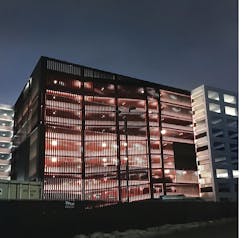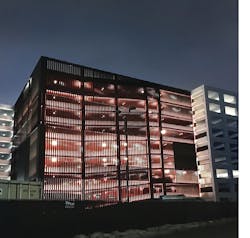As a large economy, California has often led the way in building and energy policy. Here JOHN WATKINS outlines how a new parking garage construction illustrates the impact of Title 24 compliance on SSL projects.
In 2016, California ranked as the sixth-largest economy in the world, with a gross domestic product of more than $2.6 trillion, according to the US Department of Commerce Bureau of Economic Analysis. Since the California Energy Commission was founded in 1974 and the building efficiency standards, known as Title 24, were first established in 1978, the state - through its increasingly robust efficiency and environmental requirements, mandates, and executive orders - has influenced policy worldwide and thereby the design and manufacture of lighting products available in nearly every corner of the globe.
Fig. 1. The plan for a parking garage at 7th and Alameda was changed from fluorescent lighting to equipping the final structure with an LED lighting and controls system that complies with California Title 24 regulations.
This influence has and continues to help shape the LED lighting industry, while contributing to LEDs' move to the front of the line as a construction and retrofit option in increasingly strict regulatory environments. Meanwhile, and of equal importance, LEDs are delivering compliance while also providing a more human-centric, comfort-aware lighting experience.
The California effect
In order to supply compliant products and be competitive within an economy as large as California's, it often makes practical fiscal sense for manufacturers to change the way they make all their products, rather than having one design for California and one design for everyone else. This is true not just because California is such a large consumer, but also because it is a powerful policy change-maker and influencer throughout the US and beyond. If regulation is initiated in California, the odds are pretty good that those same standards will be replicated and initiated in more states within a matter of a few years. The impact that California's regulatory environment has had on national and global environmental policy is well documented and spans multiple industries. It is referred to as the "California effect" and has influenced design and engineering decisions in everything from vehicle emission systems to fuel standards and, of course, the lighting industry.
In our own corner of the efficiency market, government mandates, combined with technological and engineering advancements, and Internet of Things (IoT) connectivity, have now brought us to LED: the most efficient and sophisticated lighting technology to date, and one that has eclipsed fluorescent - the former efficiency champion - in terms of delivering on the requirements of an even more stringent era of efficiency compliance. Policies like California's Title 24 are influencing the industry and pushing more LEDs on the market, because LEDs can deliver the required efficiency while saving commercial building owners millions in energy costs.
Case study: The 7th & Alameda parking garage
A project that illustrates this phenomenon is a 10-level parking structure located at 7th and Alameda in downtown Los Angeles (Fig. 1). The initial plans for the garage called for fluorescent lighting fixtures, but due to several factors, by the time the project was ready to break ground, advancements in LEDs made it a more compelling lighting option - so much so that the architects, Choate Parking Consultants, Inc., revised their design and replaced the planned fluorescent lighting system with an LED system, which in turn allowed for greater efficiency and more sophisticated controls. The 7th and Alameda parking garage is one of the earliest projects in California to be switched to LED with controls when originally specified for fluorescent, and it represents a bellwether moment in the industry's move toward widespread LED adoptions.
The project, installed by Apollo Electric, utilized more than 2200 FSC L6000 fixtures manufactured by FSC Lighting. The original fluorescent specifications called for four-lamp 32W T8 striplights at a fixture wattage of 112 and an annual kWh expenditure of 2,185,934.
The LED alternative solution was an LED bar radial wrap with a fixture wattage of 54 and an annual kilowatt-hour (kWh) expenditure of 790,450 (Fig. 2). The switch to LED resulted in energy savings of nearly 1.4 million kWh annually and annual energy cost savings of $167,000.
Controls and Title 24 compliance
Meanwhile, the prior fluorescent lighting plan had an inefficient controls strategy, while the LED plan provided for occupancy and daylight sensors at the fixture level, which exceeded the mandatory 2013 Title 24 update that went into effect in 2014. Parking garages are classified as indoor spaces under Title 24 and must follow the guidelines of 130.1(c)7B, in addition to having a number of garage-specific regulations housed in Section 130.2 (see a PDF at http://bit.ly/2EppcfK). [Editor's note: While Title 24 classifies parking garages as "indoor spaces," we at LEDs Magazine treat this SSL application as outdoor lighting due to the typically harsher environmental conditions and wet-location factors, and the fact that parking structures are generally not fully-enclosed buildings.]
Building value with standards in commercial lighting projects
Many California regulations are often regarded as the "gold standard" in terms of building code, energy efficiency, performance requirements, and more. Check out these features on other regulatory guidelines and industry standards that also help in optimizing SSL design schemes to meet efficiency, cost, control, wellbeing, and sustainability objectives.
Chart the course of energy-efficient SSL through lighting regulations
Lighting control requirements will drive building energy reduction
A building well lit and well controlled is WELL certified
You can get additional lighting insider insights on analyzing cost and valuation of LED lighting retrofits and new commercial construction projects in the following features.
Consider entire LED-project package to evaluate SSL project financials
Commercial LED retrofit justifies project with market value increase
SSL lightens the burden of the urban car park
While automated, multilevel device and system lighting controls and sensors are now mandatory inclusions for indoor parking areas, according the University of California Davis fact sheet, "What's New in the 2013 Code - Changes to mandatory Title 24 lighting requirements," there are other parking-garage-specific control measures, whose implementation is made possible by LED lighting systems (download the fact sheet at http://bit.ly/2Emigjf). Some of these include having lighting that is managed by "occupant sensing controls having at least one control step between 20% and 50% of design lighting power." Lighting must be able to reduce power to zero "when primary sidelit zones receive sufficient daylight to reach illuminance levels above 150% of that provided by electric lighting when no daylight is available …" Finally, lighting must be controlled by independent automatic photocontrols, and as stated in the literature, "automatic daylighting controls must be multi-level, continuous dimming or on/off."
The 7th & Alameda LED system used intelligent lighting controls to meet these requirements with a two-pronged approach:
• Dimming based on occupancy sensors
• Fully turning the fixture off based on daylight sensors
The 2013 Title 24 update also required that all buildings greater than 10,000 ft2 be capable of participating in utility-driven automated demand response events. The LED fixtures are future proofed to comply, while the original fluorescent plan was not.
Functional and environmental impact
In addition to the aforementioned savings and compliance benefits of switching the project from fluorescent to LED, there are also several functional and human-centric benefits to the final lighting plan.
Fig. 2. The FSC L6000 LED bar radial-wrap fixtures save the garage operator nearly 1.4 million kWh of energy annually.
The SSL system was designed so the fixtures were installed over individual parking spaces, and could easily be upgraded to tie into the garage's interactive parking guidance system for the presale of individual spaces.
Because the parking garage is in downtown Los Angeles, high-temperature performance was a key consideration. The fixtures are warrantied for full-life performance in ambient temperatures up to 122°F.
The parking garage isn't in an area of Los Angeles that is gentrifying, but is currently not known for being very safe after dark. The operator therefore wanted very bright, even lighting to help customers feel safe. The LED lighting system allowed for this more human-centric goal while still maintaining Title 24 compliance.
LED lighting solutions provided improved visibility while virtually eliminating the issue of glare that can cause problems for drivers navigating in tight spaces.
California and Title 24 paving the way
California's ultimate goal with Title 24 is to achieve Zero Net Energy for new commercial construction by 2030. And while the ever-more-stringent guidelines pose new challenges for developers and building product designers, the goal is ultimately one that results in cost savings for the building owner - which is good for development, tenancy rates, and ongoing building upkeep and updates - and ultimately impacts the greater economy.
By switching to an LED lighting plan with advanced building intelligence controls, the parking garage at 7th and Alameda will have saved its first million dollars in energy costs in just over six years, and over the course of those years will have saved over 8 million kWh in energy.
These savings, both in costs and energy, do not go unnoticed by the world at large. Other states pay attention to California as new technology and more efficient products and systems are implemented; and if proven successful, there is a tipping point that occurs as other states get on board. We predict that the 7th & Alameda project and others like it are just the start of a major shift toward more widespread commercial LED system adoption - for efficiency, cost savings, sustainable development, and occupant comfort and safety.
JOHN WATKINS is president of FSC Lighting, where he oversees product development, sales, and marketing of energy-efficient lighting.







